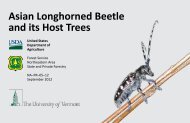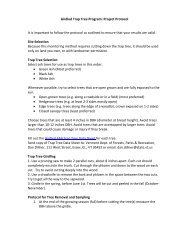BITTERSWEET - Vermont Invasives
BITTERSWEET - Vermont Invasives
BITTERSWEET - Vermont Invasives
You also want an ePaper? Increase the reach of your titles
YUMPU automatically turns print PDFs into web optimized ePapers that Google loves.
<strong>BITTERSWEET</strong><br />
invasive<br />
fact sheet<br />
Asiatic bittersweet<br />
invades <strong>Vermont</strong>’s<br />
forests and fields. It is<br />
easy to see in the fall<br />
when its red and yellow<br />
fruit lines its vines.<br />
© John Randall/The Nature<br />
Conservancy<br />
fruit: yellow<br />
outer cover with<br />
inner red flesh<br />
© Stacey Leicht/IPANE<br />
Asiatic bittersweet<br />
light green, alternate<br />
leaves that spiral<br />
around stem<br />
woody stem<br />
© Leslie Mehrhoff/IPANE<br />
DID YOU KNOW?<br />
The leaf shape and fruit<br />
color of Asiatic bittersweet<br />
(Celastrus orbiculatus) have a<br />
very similar appearance to<br />
the native <strong>Vermont</strong> vine,<br />
American bittersweet<br />
(Celastrus scandens). The best<br />
way to distinguish between<br />
the two plants is by the<br />
location of the flowers and<br />
fruits on the stem. On the<br />
invasive Asiatic bittersweet,<br />
they are scattered along the<br />
entire stem (above), while<br />
on the native American<br />
bittersweet, they are found<br />
at the terminal end of each<br />
stem (below).<br />
Asiatic<br />
bittersweet<br />
American<br />
bittersweet<br />
Photos © IPANE<br />
The Nature Conservancy, Montpelier, <strong>Vermont</strong><br />
802-229-4425 x120<br />
www.vtinvasives.org
<strong>BITTERSWEET</strong><br />
Mechanical control:<br />
For small plants: Hand pull entire plants, including all<br />
roots and runners. Place everything into a plastic bag<br />
for disposal.<br />
For large plants: Cut climbing or trailing vines close<br />
to root collar. Repeat every two weeks.<br />
Chemical control:<br />
Foliar spray: This method is best used for dense<br />
populations. In the fall, when native plants are losing<br />
their leaves, spray a 2% glyphosate or triclopyr solution<br />
on the entire leaf surface of the plant. In order to<br />
avoid drift to native plants, spray on calm days.<br />
Cut stump: Cut plant 4 inches from ground in fall.<br />
Treat stumps with a triclopyr herbicide. Glyphosatebased<br />
products are not strong enough for this plant.<br />
√<br />
√<br />
√<br />
√<br />
√<br />
Safe Chemical Application<br />
Develop an Integrated Plant Management approach. Use chemical<br />
control as only ONE piece of your prevention and management<br />
strategy.<br />
The label found on the herbicide container is the law. It indicates the<br />
concentrations to use, what protective clothing to wear, how<br />
to apply the product, and what environmental and human<br />
health hazards are associated with the chemical.<br />
Use aquatic formulations within 10 feet of water. You need a permit<br />
to apply herbicides in wetlands. Do not apply herbicides<br />
within 100 feet of a wellhead. Contact VT DEC at 802-241-<br />
3761.<br />
You need to be certified to apply herbicides on land that you do not<br />
own.<br />
Hire a contractor to manage large infestations. A good contractor<br />
will have the knowledge to help create an effective management<br />
plan. For a list of certified contractors, contact the VT<br />
Department of Agriculture at 802-828-3482.<br />
DO NOT COMPOST THIS PLANT! Plant fragments can re-sprout.<br />
Non-invasive Alternatives<br />
trumpet<br />
honeysuckle<br />
© Joseph A. Marcus/Lady Bird Johnson Wildflower Center<br />
trumpet vine<br />
Campsis radicans<br />
© Joseph A. Marcus/Lady Bird Johnson Wildflower Center<br />
Virginia creeper<br />
Parthenocissus quinquefolia<br />
Lonicera<br />
sempervirens<br />
American<br />
bittersweet<br />
Celastrus<br />
scandens<br />
© Joseph A. Marcus/Lady Bird Johnson Wildflower Center<br />
© Native Plant Nursery/nativeplant.com<br />
The Nature Conservancy, Montpelier, <strong>Vermont</strong><br />
802-229-4425 x120<br />
www.vtinvasives.org














